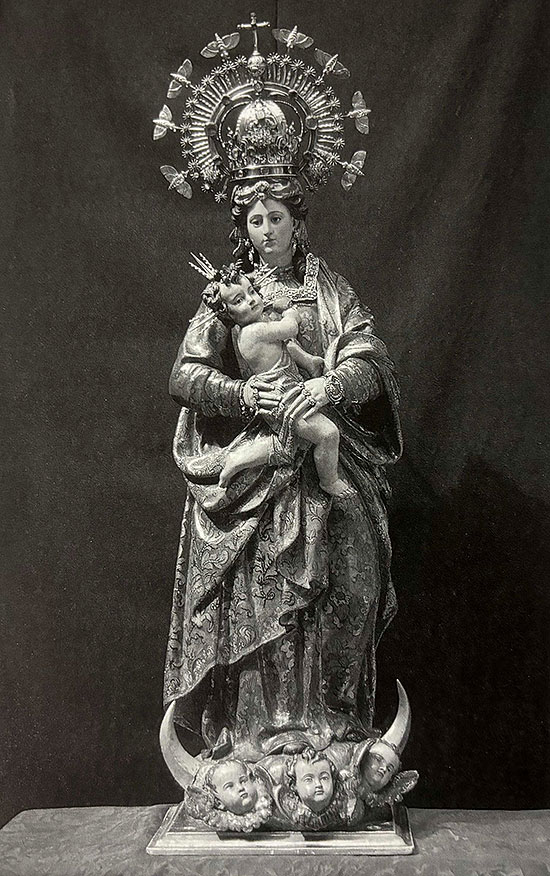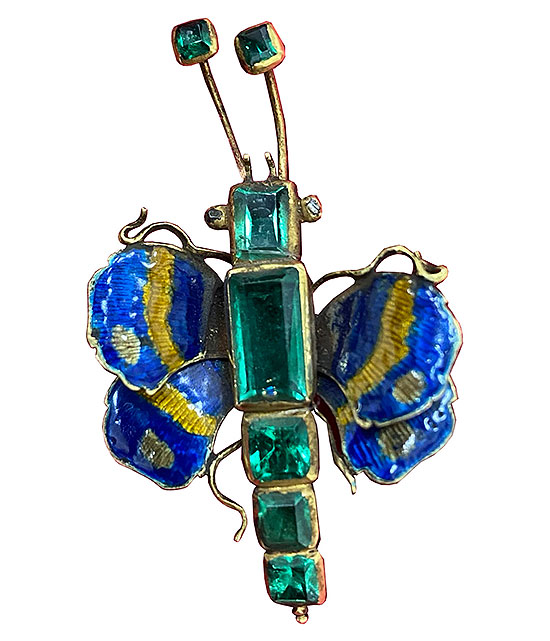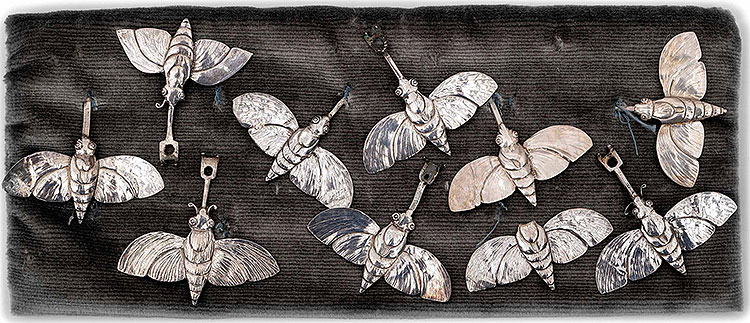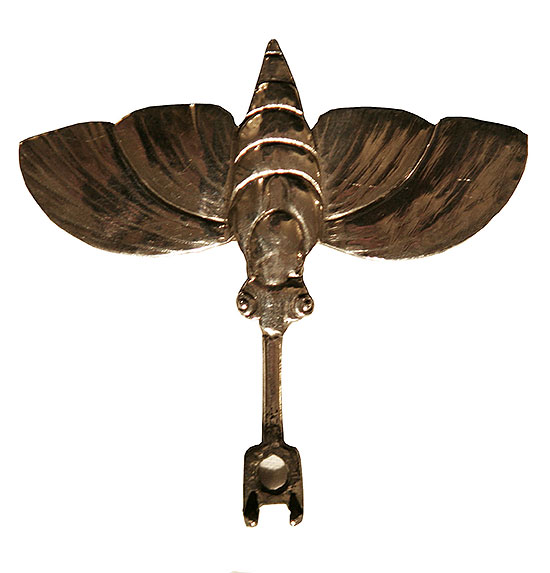The piece of the month of July 2024
A UNIQUE EXAMPLE OF CIVIL JEWELRY APPLIED TO RELIGIOUS IMAGES. THE BUTTERFLIES OF THE VIRGIN OF THE WONDERS OF PAMPLONA
Ignacio Miguéliz Valcarlos
Museum of the University of Navarra
The Virgen de las Maravillas, kept in the convent of the Recoletas in Pamplona, became one of the main devotions of Pamplona throughout the Baroque and 19th centuries, only behind the Virgen del Camino, venerated in her chapel in the church of San Saturnino, and ahead of the Virgen del Sagrario in the cathedral, a devotion linked to the bishop and canons of the cathedral, and above all of San Fermín, a figure of greater recognition in Pamplona in our days.

The image of the Virgin arrived at the convent in 1655, thanks to a vision that Friar Juan de Jesus and St. Joaquin, a Carmelite friar of the convent of the Discalced Carmelites, had, and to the miraculous healing of Mother Josefa de San Francisco, prioress of the Recollects. In this vision, the Carmelite friar witnessed how the figure of the Virgin came to collect the soul of the seriously ill Recollect prioress, who nevertheless recovered. Later, the same friar found an image of the Virgin equal to the one in his vision, which was in poor condition in a private house and on which a small debt weighed. The prioress of the Recollects gave the amount owed to the Carmelite friar so that he could rescue the image and take it to the convent, where it was received by the nuns with great devotion, taking it to be restored first in Pamplona and later in Madrid, where the base of clouds and cherubs was added. After assigning it the title of Nuestra Señora de las Maravillas, the image was first placed in the cloister and later moved to the church in 1674, ready for the adoration of the faithful, soon becoming one of the main devotions of Pamplona. Thanks to this, the image soon received many gifts and bequests, among them, numerous gold, silver and rhinestones jewels.
The donation of this subject of objects to the images of devotion will be common over time, even up to the present day. The submission of a jewel or other donation reaffirms the status and fortune of the person who donates it submission, as well as the lineage to which it belongs, thus acquiring these pieces, in addition to their economic value, a value of representation, and the higher this value is, the greater the resonance of the donation and the fame of the donor. In the same way, it is sought that the given jewel is placed to the sacred image, since this way it acquires an almost thaumaturgical sense; the person who has bequest the jewel obtains in an empathic way to be placed close to the divine, when the sacred image is dressed with the same object with which it is adorned.
The jewels given to Our Lady were kept in the Virgin's trousseau and were used either permanently or reserved for use in the main festivities celebrated in the convent. Most of the jewels donated to the Virgin since her transfer to the church in 1674 and throughout the 18th century were lost in the War of Independence against the French (1808-1814), when the nuns were forced to sell part of the silver and jewels of the Virgin to be able to subsist, sales that were later repeated occasionally. Most of the preserved pieces, which are but a pale reflection of what once existed, are of a civilian nature and link the jewelry worn by the Virgin with the feminine fashion of the Baroque period. Among them are a butterfly of gold, emeralds and enamels, and a set of silver butterflies, all datable to the last quarter of the seventeenth century.

The first is a piece of small dimensions, with the body formed by five emeralds of different sizes, square and rectangular cut set in gold and arranged in a row. To the upper emerald, which acts as head, are attached two small buttons set with table-cut diamonds, which act as eyes, and two threads, as antennae, topped by two square-cut emeralds; while the second emerald, which acts as thorax, is attached to each side of translucent enamel wings in blue and yellow, which has small losses, as well as four gold threads as legs. There follow three more emeralds, square cut, in decreasing size forming the abdomen. Among the documentation preserved in the convent there are some news that could make reference letter to this piece. In the inventory of jewels of the Virgin of 1731 it is included "A butterfly of emeralds, a cross of emeralds and diamonds, some emerald earrings, and a gold chain with an enameled handle and its sparks of diamonds were left by D.ª María Bernarda de Echeverría". However, in an increase of the Virgin's jewelry after 1731, which completes the inventory, it appears "a small butterfly enameled and adorned with emeralds and a gold papaganso enameled and adorned with diamonds were given by D.ª M.ª Antonia de Ripalda". The making of jewelry in the shape of animals is a constant in Spanish jewelry since the 16th century, as we can see in the pinjantes in the shape of a mermaid, lion or lamb that existed in the same trousseau of the Virgin. In the case of butterflies, we can add the fact that in the last quarter of the 17th century, insect-shaped head ornaments became fashionable, as attested by the Countess d'Aulnoy in the chronicle of her trip through Spain "and on the head, combed in different ways and always uncovered, many hairpins topped with diamond flies or butterflies of rubies and emeralds".
The use of this naturalistic jewelry subject was very fashionable in the last quarter of the seventeenth century, as we can see in the female portraits of Philip IV, Charles II and Philip V, also obeying this typology the so-called 'airones', bouquets or 'piochas', jewelry that was placed on the chest or in the female hair. These pieces were articulated in the form of a floral bouquet, with a vase from which a series of flowers were arranged with birds or insects set with gemstones and enameled, as we can see in the example preserved in the trousseau of Our Lady of the Tabernacle of the cathedral of Pamplona. Flowers and animals were attached to the vase by means of wires and springs, which vibrated with the movement and made the gemstones with which they were set sparkle under the effect of the light, to which the rich color of the enamel that covered them had to be added. In addition to the aforementioned cathedral airon, there is another piece of great singularity in Pamplona with this ornamentation subject , in this case a work of religious character but with decoration following the feminine fashion of the time: the mitre and crozier of Saint Fermin donated to the Saint in 1766 by Felipe de Iriarte, a native of Alcoz, in Ulzama, and resident in Mexico: "a rich silver mitre over gilded with its pastoral crozier, adorned with flowers of exquisite filigree and a variety of stones, butterfly tembleques and golden scorpions of rare beauty and pilgrim beauty". Both pieces present a rich ornamentation of incised and openwork flowers, in silver filigree in its color and stained glass, which is articulated around plant and floral elements that simulate a rose bush, on which are arranged different insects, such as butterflies and small scorpions, the latter gilded. Several of these elements are attached to the mitre by means of threads and springs, like tremblers or tembleques, as Felipe de Iriarte calls them.

The second piece to be studied is a set of ten silver butterflies in their color, pieces of little Issue, with a flat and frontal character, with the profile marked. They are articulated by means of an arrowhead-shaped body that marks the different parts of the body by means of parallel incised curved stripes, differentiating a triangular head followed by a conical body that encompasses the thorax and abdomen, from which depart convex wings also articulated by means of incised lines. From the head of the butterflies there is a rectangular stem or spike to attach the butterflies to the crown. They are very simple, but very showy pieces, cut in silver plate, whose volumes are outlined by incised stripes in the conical body as well as in the wings. In the documentation conserved in the convent there is no news of these butterflies, which are used as ornament in the crown of the Virgin of the Wonders, finishing off its potencies and suns, although they do appear already represented adorning the crown of the Our Lady in a baroque painting of the middle of the XVIII century, as a trompe l'oeil. The crown on which the butterflies are placed is a mid-17th century piece, probably carved by a local master, in imitation of the one made in Madrid by the silversmith Francisco Gallo for the carving of the Immaculate Conception, an image made in Madrid by Manuel Pereira in 1649, also for the convent of the Augustinian Recollect Nuns of Pamplona.

As we can see, this is a set of exceptional works of which we know of no equivalents in any other Marian treasure and neither in civil nor institutional collections, being perhaps the most similar piece a butterfly that is part of the decoration of the pendant of a pectoral of the trousseau of the Virgin of Grace of Carmona. It is a piece with the thorax carved in gold that presents an emerald set in the trunk, with wings on the sides of blue, yellow, green and honey enamel. Other insects from subject articulated by gem-set stones from the same period as the butterflies studied here are a diamond butterfly set in the mantle of the Madonna della Lettera of Messina or the dragonfly from the Rothschild collection belonging to the British Museum in London.
SOURCES AND BIBLIOGRAPHY
file Augustinian Recollect Sisters of Pamplona, Libro de Inventario de la casa, iglesia y sacristía, fols. 207-209.
file Municipal de Pamplona, conference proceedings Municipales, Libro n.º 42, 1762-1766.
D'AULNOY, M. de, Relación del viaje por España, Madrid, Akal, 1986.
DI NATALE, M.ª C., Gioielli di Sicilia, Palermo, Flaccovio editore, 2000.
FERNÁNDEZ GRACIA, R., Tras las celosías. Patrimonio material e inmaterial en las clausuras de Navarra, Pamplona, University of Navarra-Fundación Fuentes Dutor, 2018.
MIGUÉLIZ VALCARLOS, I., "El joyero de la Virgen del Sagrario en los siglos del Barroco", in R. Fernández Gracia, La catedral de Pamplona. Homage to Don José María Omeñaca. Cuadernos de la Chair de Patrimonio y Arte Navarro, Pamplona, Chair de Patrimonio y Arte Navarro, 2006.
MIGUÉLIZ VALCARLOS, I., "The treasure of San Fermín. Donación de alhajas al Santo a lo largo del siglo XVIII", in R. Fernández Gracia, Promoción y mecenazgo del arte en Navarra. Cuadernos de la Chair de Patrimonio y Arte Navarro, Pamplona, Chair de Patrimonio y Arte Navarro, 2007.
MIGUÉLIZ VALCARLOS, I., "Pérdida de las ahajas de plata de la Iglesia en Navarra durante la Guerra de la Independencia (1808-1814)", in R. Fernández Gracia, programs of study sobre el patrimonio cultural y las artes en Navarra en torno a tres hitos 1212-1512-1812, Príncipe de Viana, n.º 256, Pamplona, Gobierno de Navarra, 2012.
MIGUÉLIZ VALCARLOS, I., Joyería en Navarra. 1550-1900, Pamplona, Chair de Patrimonio y Arte Navarro, 2018.
SÁENZ RUIZ DE OLALDE, J. L., Monasterio de Agustinas Recoletas de Pamplona. Three centuries of history, Pamplona, Government of Navarra, 2004.
THORNTON, D., A Rothschild Renaissance. Treasures from the Waddesdon Bequest, London, The British Museum, 2015.
VVAA, La Virgen de Gracia de Carmona, Carmona, Hermandad de Nuestra Señora la Santísima Virgen de Gracia, 1990.
